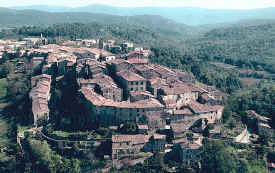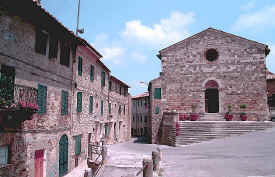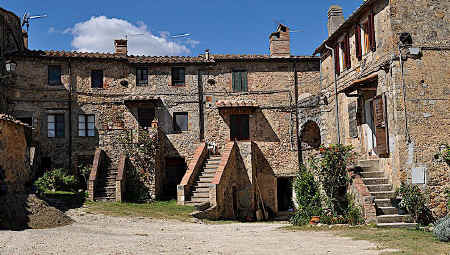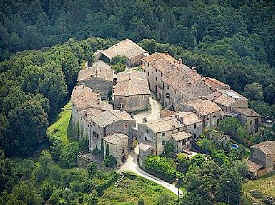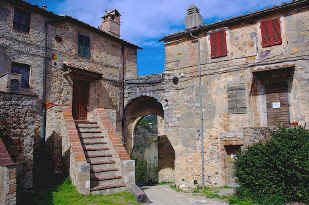|
The river Farma marks the natural boundary between the provinces of Sienna and
Grosseto
in Tuscany, Italy, before joining the Merse and flowing into the Ombrone
and so to the sea near Grosseto. Monticiano is located on a hill overlooking the river Merse, a short
distance from the Abbey
of San Galgano.
During the mediaeval period, Monticiano was a possession of the Bishops of
Volterra,
when it had a castle, and then in the 13 C it fell under the control of
the Siennese and later the Florentines. In the 17 C, the Medici conceded it as a fief to the Counts of Elci.
The late-Romanesque Church of Sant’Agostino (1291-1362) which has
a later baroque interior, is situated at the entrance to the main piazza
of Monticiano. In the adjacent former monastery, the chapter house is decorated with a cycle of monochrome frescoes
depicting the Passion by the Siennese painters Bartolo di Fredi, Guidoriccio Cozzarelli
and Giovanni di Paolo and a Virgin Enthroned with St Augustine and the Blessed Antony de'Patrizzi by
a Siennese painter influenced by Taddeo di Bartolo (1422). This monastery
is in Gothic style and is one of the oldest Augustinian hermitages. It was part of the same Augustinian congregation
that included the convents of Lecceto, San Leonardo al Lago and Santa Lucia.
Higher up in the old part of Monticiano, there is the Church of Saints Giusto
and Clemente, founded in the 12 C, with a facade in square-hewn stone, a portal decorated with palmettes and a curiously small bell-tower. Also
worth seeking out are the Palazzo Callaini and the Antico Spedale, transformed into a church, where there is a curious decoration under the side-door: a snake with a lily in its mouth.
The area around Monticiano has numerous forest and country paths that are
ideal for hiking, bicycling and horse riding. There are numerous rare
plant and animal species, including otters, alpine newts and freshwater
crabs. Worth seeing are the locality of
San Lorenzo a Merse with the ancient castle and the Romanesque
church, the hamlet of Castello di Tocchi, the ruins of Castellaccio, Monte Quoio and
Renna, as well as the villages of Iesa, Scalvaia, Bagni di Petriolo,
Torniella
and Il Santo.
|
